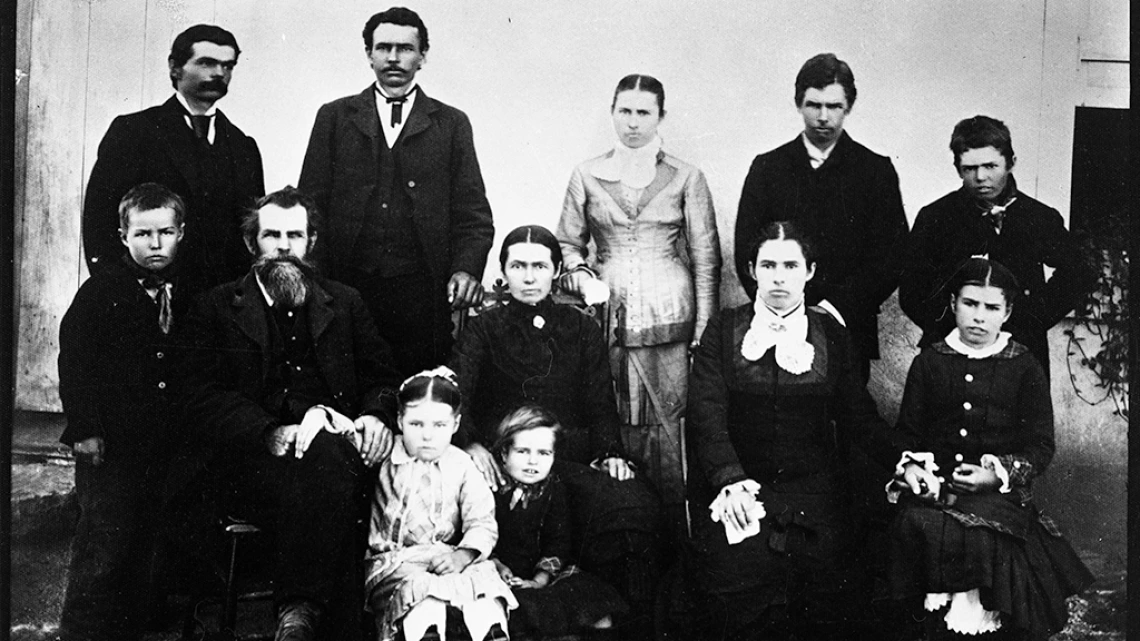Riggs family papers

Brannick and Mary Riggs with their 10 children, circa 1880. The Riggs family settled in the Sulphur Springs Valley in Cochise County, Arizona Territory in 1879; MS 580 and Box 7, folder 1.
Collection dates: 1878-1998 bulk (bulk 1900-1942)
Papers, 1878-1998 (bulk: 1900-1942). This collection contains the papers of John Casey Riggs and various other family members. The collection was donated by John Casey Riggs’ grandson, Chris M. Roll, in 2007. The Riggs family Bible, and the diaries of Mary Robbins Riggs from 1896 to 1929 were donated by Nancy Sloan and added to the collection in 2011. John Casey Riggs, was the family historian, therefore, the bulk of the papers are his. The collection includes Our El Dorado, a biographical book written by John C. Riggs and his daughter, Jeanette Riggs Roll, and the Riggs Centennial Reunion, 1879-1979 book. Also included in the collection are biographical manuscripts, Valparaiso University certificates of diploma; diaries, notebooks, and journals; business and personal correspondence, including a handwritten letter to John Riggs from Albert F. Potter, first Chief of Grazing for the U. S. Forest Service, dated 1902; business records and ledgers; printed materials, including pamphlets, catalogs, newspapers and clippings, homestead land and mine patents, and an original 1910 mining claim signed by President William H. Taft; the political papers of John Casey Riggs, Arizona State Senator; maps; photographs and negatives.
John Casey Riggs (1874-1943) was the eighth of ten children born to Brannick Riggs (1828-1907) and Mary Robbins Riggs (1838-1935), pioneer homesteaders from Texas who arrived in the Sulphur Springs Valley area of southeastern Arizona (Cochise County) in 1879. John Casey Riggs was born in Los Animas County, Colorado in 1874 and traveled by oxen and wagon with his family in 1877 to join other Riggs relatives in the Dos Cabezas gold mining district of Arizona with a herd of horses and about eight head of cattle. The Riggs family established themselves in the area as ranchers, bankers, and state and local politicians, as well as attorneys, teachers, miners and loggers in this part of southeastern Arizona where many of their offspring continue to live and work. They established the Riggs Cattle Company in 1904 and the Riggs Bank of Willcox, AZ in 1920. Family stories in the collection tell of the tragic deaths of Brannick Riggs’ brother John and his wife, Jane, in Bell County, Texas by Comanches in 1857, the final years of the Chiricahua Apache Wars and raids on neighboring homesteads, and the earthquake of 1887 that shook southern Arizona, to name a few.
John Casey Riggs graduated from Valparaiso University in Indiana in 1894 and obtained his law degree in 1906. He practiced law in Tombstone, Arizona until 1911. He then became general manager for the Riggs Cattle Company until 1917. He helped organize the Riggs Bank in 1920, and after it closed in 1933, he was elected to the Senate of the Eleventh State Legislature. He married Jeanette (Nettie) Mary Brauns of Upper Sandusky, Ohio in 1910, and together they built the John Riggs Ranch. They had four children, Paul William Riggs (1911-1990), John Stark Riggs (1912-1998), Ellerbe Brauns Riggs (1915-2007), and Jeanette Mary Riggs (1916-2004), who continued to marry and settle on ranches in the same area where their family has resided since 1879. The Riggs family celebrated their centennial in Arizona with a family reunion in 1979 in Willcox, AZ.
A collection guide explains what's in a collection. New to using our collections? Learn how to use a collection guide.
Collection guideAccess this collection
Visit us in person to access materials from this collection. Our materials are one-of-a-kind and require special care, so they can’t be checked out or taken home.
How to cite
Learn how to cite and use materials from Special Collections in your research.
